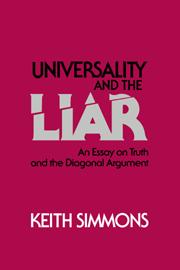Book contents
- Frontmatter
- Contents
- Preface
- Chapter 1 The Liar paradox
- Chapter 2 The diagonal argument
- Chapter 3 The diagonal argument and the Liar, I
- Chapter 4 The diagonal argument and the Liar, II
- Chapter 5 A medieval solution to the Liar
- Chapter 6 A singularity solution to the Liar
- Chapter 7 A formal account of singularities
- Chapter 8 Applications and further singularities
- Chapter 9 Semantic universality
- Notes
- Bibliography
- Index
Chapter 8 - Applications and further singularities
Published online by Cambridge University Press: 19 October 2009
- Frontmatter
- Contents
- Preface
- Chapter 1 The Liar paradox
- Chapter 2 The diagonal argument
- Chapter 3 The diagonal argument and the Liar, I
- Chapter 4 The diagonal argument and the Liar, II
- Chapter 5 A medieval solution to the Liar
- Chapter 6 A singularity solution to the Liar
- Chapter 7 A formal account of singularities
- Chapter 8 Applications and further singularities
- Chapter 9 Semantic universality
- Notes
- Bibliography
- Index
Summary
In Section 8.1, we apply our formal account to a variety of Liar-like examples. In Section 8.2, we investigate further the singularities of a given occurrence of ‘true’.
APPLICATIONS OF THE FORMAL ACCOUNT
Example A. Consider a familiar empirical case adapted from Kripke. Suppose Nixon says
(1) All of Dean's utterances about Watergate are not true.
And suppose Dean asserts
(2) Everything Nixon says about Watergate is not true.
Each of these utterances includes the other in its scope. This need not mean that we are unable to assign truth values to (1) and (2). Under certain empirical assumptions, we can. If, for example, Dean has made at least one true0 statement about Watergate, call it ‘[d]d’, then it is easy to check that (1) is grounded and false0. For then (1) has a g-witness whose first node is ([1]1, F) (see diagram at top of facing page, where ‘D’ abbreviates ‘is an utterance of Dean's about Watergate’). If, further, every other statement of Nixon's about Watergate is false0, then it is easily checked that (2) is grounded and true0.
But suppose that all Watergate-related statements made by Nixon and Dean, other than (1) and (2), are false0. Then (1) and (2) are pathologically tangled: Each depends for its truth value on the truth value of the other. There are no g-witnesses for (1) and (2): They are ungrounded. We are now interested in the basic trees for (1) and (2).
- Type
- Chapter
- Information
- Universality and the LiarAn Essay on Truth and the Diagonal Argument, pp. 142 - 158Publisher: Cambridge University PressPrint publication year: 1993



